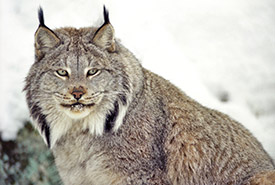Meeting wildlife in the wilds of Cape Breton

Canada lynx (Photo by Shutterstock)
This story was written by Kathryn Morse, as told by Danielle Horne.
My work on the Nature Conservancy of Canada’s (NCC’s) stewardship team in Nova Scotia means that I spend several months in the field every summer and fall, monitoring our nature reserves. One of my favourite places to work is in Cape Breton. From the age of three, I spent part of every summer in this beautiful and wild part of the province, so working there for NCC feels like going home.
Related content
One September afternoon a few years ago, as we were finishing our stewardship work near Iona, in central Cape Breton, my colleague Doug and I decided to check out a local waterfall. The trip literally involved taking the road less travelled — an old dirt road with very few houses. It's where I had a brief but memorable wildlife encounter.
As I drove over a crest on the road, I suddenly saw something I’d never seen before, or since: a Canada lynx. And not only one lynx, but a mother lynx with her two teenage cubs. The surprise of seeing them, and the stunning beauty of this family, left me speechless. I had stopped the car but wasn’t able to say a word to Doug, who was sitting in the passenger seat next to me, and who missed the amazing sight by the roadside.
Within seconds, the three lynxes had vanished into the shrubs and grass, almost like a mirage. But their image was seared into my brain. Before they disappeared, the mother lynx paused and looked directly at us. I saw the black tufts of hair on the tips of her ears and noticed as she turned away that her back legs were higher/taller than her front legs, a characteristic that distinguishes lynx from bobcat.
Canada lynx are found throughout the northern United States and Canada, mainly in boreal forests. In Nova Scotia, the species has been listed as a species at risk since 2002. Lynx prefer dense, mature forests, higher elevations and larger territories where they won’t encounter people, like sparsely settled Cape Breton.
Snowshoe hares are the lynx’s preferred prey, making up 75 per cent of its diet. Because snowshoe hare populations go through rapid increases and sudden crashes, lynx also experience dramatic cycles.
Threats to lynx include climate change (less snowfall and changing prey patterns), the geographic isolation of lynx populations and habitat loss. In Atlantic Canada, NCC is actively working to protect forest habitat for lynx and other larger mammals, including 400 hectares (988 acres) and growing in Cape Breton.
Given how rare lynx are in my part of the world, and how elusive they are in general, to see three at once was an incredibly lucky encounter. Had we been travelling a minute sooner or later, or had I happened to look at something on the opposite side of the road at that moment, I likely would have missed seeing a sight that still inspires me to this day.
The Canada lynx is one of 19 species featured in NCC’s gift giving campaign: Gifts of Canadian Nature. To learn more and to give the gift of conservation this holiday season, click here.



